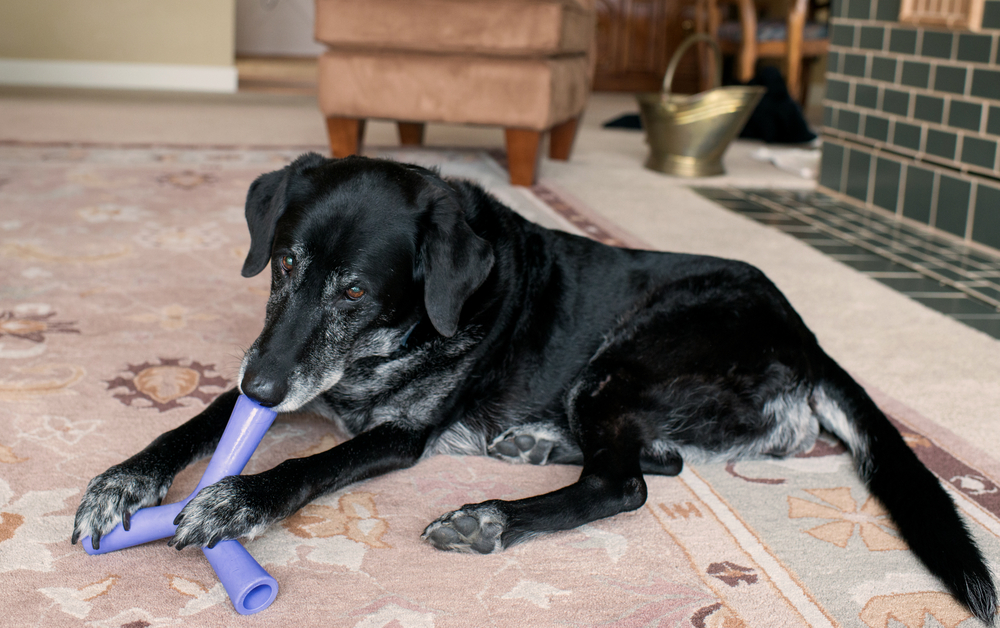The outward sign of a dog’s senior status is often the gray muzzle. But aging is also occurring within your dog’s body, including the brain.
Fortunately, experts confirm what we have always hoped: You can teach an old dog new tricks and the payoff may result in a healthy brain up for new challenges.
“Yes, canine cognitive dysfunction is a very real issue for older dogs,” says Kathryn Primm, DVM, owner and chief veterinarian at Applebrook Animal Hospital in Ooltewah, Tennessee. “But aging is as individual as they are. Yes, brains age, but because of the amazing plasticity of the brain, we can actually find ways around some of the changes.”
Good old dogs are getting their well-deserved recognition and added help, thanks to veterinarians like Dr. Primm and groups such as The Grey Muzzle Organization.
Quality of Life
“Senior dogs have always been my soft spot,” says Denise Fleck, president of The Grey Muzzle Organization, who shares her home with a senior dog named Haiku. “There’s a unique wisdom and peace when a dog feels loved in his golden years that comes right through his eyes. The love of an older dog is such a special love.”
Fleck, a best-selling pet author and a certified pet first aid/CPR instructor known as the Pet Safety Crusader, shares several ways to work your dog’s brain in a healthy way with a healthy purpose:
“Brain health is important to your dog’s quality of life and if you don’t move it, you lose it, and that can mean brain cells, too,” says Fleck.
Exercise Those Little Gray Cells
Ready to unleash some canine brain calisthenics on your senior dog?
* Puzzle games. “Take three paper cups or empty and cleaned yogurt containers. Punch a hole to allow the scent to more readily escape and let your dog watch your put a treat under one cup. After he catches on, knock the cup down for the reward. Then mix up the cups to let him choose and of course, let him have more than one try to find the treat.”
Adds Dr. Primm, “Hiding treats around the house is a fun idea to keep older dogs moving and thinking. Puzzle toys are great, but you need to rotate them so they don’t get used to the same one.”
* Physical stimulation. If your pet enjoys or seeks out touch, it can help to keep his brain agile. “Tickle your senior dog pal on the face, as it stimulates the cranial nerves that work the mid-brain,” says Fleck. “Gently tickling your dog’s toes can also keep reflexes sharp.” To enhance the experience, you can pair it with treats, especially if your dog isn’t used to having face or paws touched.
* Work their noses. “Nose work is an excellent activity as dogs have more than 200 million receptor cells in their snouts compared to the five million humans have,” says Fleck. “Just remember for any of these treat-based reward games, limit the calories so your pooch doesn’t pack on the pounds. Carrot slices, dehydrated sweet potato chips, fresh zucchini slices, and even small tuna or salmon juice ice cubes can be winners.”
* Add brain food and supplements. Working with your veterinarian, consider foods rich in antioxidants as they are shown to boost learning and spatial attention. Consider these brain foods to dish up to your dog: blueberries, raspberries, carrots, spinach, and kale. “Chop finely to enhance their digestibility,” Fleck says.
Dr. Primm says it is vital to book at least annual wellness veterinary visits for your senior dog. Twice a year is better.
“As dogs age, their chances of having some form of cancer increases, so regular vet visits are key,” says Dr. Primm. “All senior dog caretakers should know what is normal for their dogs. Monitor thirst and urination, appetite, weight, and stool characteristics.”
She also says to keep an eye on your senior dog’s attitude or temperament.
“Changes in anxiety or FAS [fear, anxiety and stress] in older dogs can also be an aging change,” says Dr. Primm. “Sight and hearing in senior dogs can be impacted in a negative way. Many of my senior pet clients are on medication to address specific issues. The most important thing is knowing what is normal, so you can alert your veterinarian to changes and let them come up with a plan tailored to your own pet.”
This article was reviewed/edited by board-certified veterinary behaviorist Dr. Kenneth Martin and/or veterinary technician specialist in behavior Debbie Martin, LVT.
Arden Moore is The Pet Health and Safety Coach. She is a best-selling author, radio show host, in-demand speaker and master certified pet first aid/CPR instructor who travels the country teaching with Pet Safety Dog Kona and Pet Safety Cat Casey. Learn more at www.ardenmoore.com and www.facebook.com/ardenmoore.








